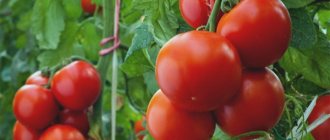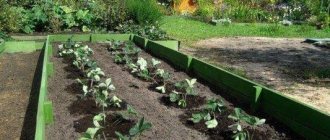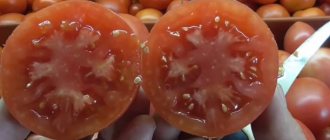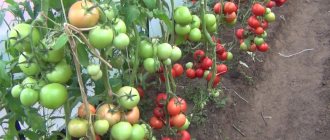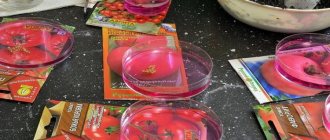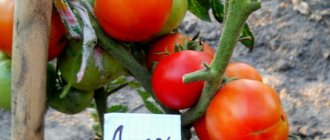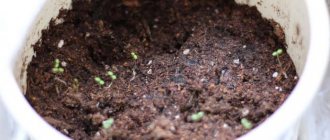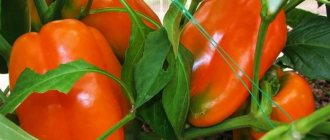Tomato Apollo - description and characteristics of the variety
Apollo is a high-yielding, early-ripening hybrid that has complex resistance to diseases and unfavorable climatic conditions. The plant is tall, up to 1.5 m. The fruits are elongated, dense, with a spout. 9-12 red tomatoes weighing 90-110 g ripen in clusters. Tomatoes begin to be grown in early spring, seedlings are planted in small forms, and after two months they are hardened off. And at the beginning of summer they are planted in a greenhouse or open ground.
Features of the hybrid Apollo
The hybrid is tolerant to sunburn, blossom end rot and cracking, and is characterized by long-term fruiting. The plant is tall, the bushes are more than 1.5 m high. The Apollo tomato requires formation, removal of stepsons, and tying. The bush is formed into one, less often two stems.
- Universal tomato. 6-8 full-fledged brushes are formed on the bush.
- The fruits are highly transportable and suitable for pickling and canning.
- The hybrid will provide a stable harvest in any weather conditions.
The unripe fruit has a green spot that disappears as it ripens. Ripe fruits of bright red color, with dense pulp.
How to prepare seeds for planting
The seeds are treated with solutions of biostimulants so that young plants are not susceptible to disease. You will need manganese (dilute 1 g in one glass of water) and soak the seeds in it; for convenience, you can put them in a fabric bag.
It is necessary to harden the seeds. For 2 days they must be kept in the refrigerator at a temperature of about +1 and periodically sprayed with water.
Prepared seeds should be planted in cells or cups in mid-February. When planting seeds, leave 2 cm between plants. Planted seeds must be kept warm at a temperature of 20-22 degrees. To make the seeds germinate faster, it is recommended to cover them with film.
Seedling care
As long as the seedlings are growing nearby in the same pot, there is no need to feed the soil.
- The pots must be turned with different sides towards the sun every day. The temperature should not drop below 16 degrees. Water as needed. When 2-3 leaves appear on the seedlings, you will have to make the first pick.
- Pots for picking should be 8x8 cm, plants should be planted in them one at a time. When picking, weak shoots are thrown out.
- After picking, seedlings need to be grown at a temperature of 16 degrees at night and 20-22 degrees during the day.
- Water the seedlings no more than once a week. After 2 weeks you can feed Apollo tomatoes. Feeding solution: 1 tbsp. spoon of nitrophoska per 10 liters of water.
- After 3-4 weeks, it is necessary to transplant the young plants into 12x12 cm pots. You will need to feed them 2 weeks after the second picking. Solution for the second feeding: 1 tbsp. spoon of superphosphate and sodium sulfate per 10 l. water. After 2 weeks, another feeding should be done.
Before planting seedlings, it is necessary to harden them. At a temperature of at least 12 degrees, the tomatoes are taken outside. Ready seedlings should have 10-12 leaves and several inflorescences, approximately 20-30 cm high.
You can use needles to prepare soil mixtures and control pests. In January - February, collect half a bucket of twigs, chop them finely and mix with the same amount of garden soil. By March, when the time comes for sowing tomato seeds for seedlings, a loose black mixture will form in the bucket. On this soil mixture, seedlings are obtained with a well-developed root system, they have dark green, strong foliage
Of course, during this process it is important to provide the seedlings with light.
Planting in open ground
Seedlings are transplanted into open ground at the end of May. In the first days after planting, you can use film to make it easier for the seedlings to adapt.
- Before planting, make holes 30 by 30 cm, fertilize them and water them. Carefully remove the finished seedlings from the containers and plant them in the holes, try not to damage the plants, they are very delicate.
The crop does not take up much space in the greenhouse because it grows upward. New buds are constantly forming on the brushes. Fresh fruits are harvested in open ground until September. Apollo tomatoes are unpretentious and very productive.
How to prepare seeds for planting
If you want to get a good harvest, you need to prepare the seeds before sowing.
Tomato seeds can be subjected to short-term heating; the temperature should not exceed 55 degrees. Warm up the seed for 2-3 hours. The seeds are treated with solutions of biostimulants so that young plants are not susceptible to disease. You will need manganese (dilute 1 g in one glass of water) and soak the seeds in it; for convenience, you can put them in a fabric bag.
It is necessary to harden the seeds. For 2 days they must be kept in the refrigerator at a temperature of about +1 and periodically sprayed with water.
Prepared seeds should be planted in cells or cups in mid-February. When planting seeds, leave 2 cm between plants. Planted seeds must be kept warm at a temperature of 20-22 degrees. To make the seeds germinate faster, it is recommended to cover them with film.
Advantages
The variety is valued for:
- high productivity;
- resistance to infections;
- good keeping quality;
- durability during transportation;
- withstand temperature changes;
- the same size of fruit;
- versatility of use
"Golden Stream" is a determinate variety. This means that the growth of the bush is limited, that is, when 5-7 clusters are formed, the plant does not develop further, all energy is spent on the formation of tomatoes. The height of the bush is a maximum of 70 cm. This is a real advantage over varieties whose growth cannot be stopped. Gardeners do not have to waste time on additional bush care and tying up.
Dark green, slightly rough leaves are few in number. Up to 8 fruits are formed on one branch.
The tomatoes are small, oval, weighing 70-80 g. They are colored yellow-orange or golden yellow. The peel is dense and does not crack during ripening.
The pulp is fleshy, juicy, there are few seeds.
An important advantage of Golden Stream is its high yield. For 1 sq.
m. can grow 10 kg. healthy tomatoes, per 1 hectare. - 35 tons. Due to its marketable appearance, good preservation and resistance to mechanical damage, tomatoes are grown for sale.
Important: the variety ripens early, so it simply does not have time to become infected with late blight.
Features of the hybrid Apollo
The hybrid is tolerant to sunburn, blossom end rot and cracking, and is characterized by long-term fruiting. The plant is tall, the bushes are more than 1.5 m high. The Apollo tomato requires formation, removal of stepsons, and tying. The bush is formed into one, less often two stems.
- Universal tomato. 6-8 full-fledged brushes are formed on the bush.
- The fruits are highly transportable and suitable for pickling and canning.
- The hybrid will provide a stable harvest in any weather conditions.
The unripe fruit has a green spot that disappears as it ripens. Ripe fruits of bright red color, with dense pulp.
Secrets of growing tomato Argonaut F1 - planting rules and care
Tomatoes are tasty and healthy vegetables that are easy to care for, which is why they are so popular. There are many varieties and hybrids that differ in color, taste, size and yield.
| Height | Landing location | Ripening time | Fruit color | Fruit size | Origin | Fruit shape |
| short | Greenhouse, Open ground | Early ripening | Reds | Large | Hybrid | Round |
The fruits are smooth, without cracks or dents, have a rich taste with a subtle sourness.
Country of origin and year of registration
The hybrid was bred in 2011, but was included in the register only in 2015. This variety was created by breeders from Russia. And in such a short period, he managed to take his place in the garden beds and in the hearts of many summer residents.
Advantages and disadvantages
- High yield
- Early fruiting
- Resistance to many diseases
- Excellent taste
- Neat, marketable fruits
- Do not deteriorate during long-term storage and transportation
- Resistance to temperature changes
Minuses:
- Tendency to overwhelm
- The need for tying
Productivity
The plant can be grown both in open ground and in a greenhouse. Under a canopy, the fruit yield is slightly higher and amounts to 4.5 kilograms per bush. In open ground, in the fresh air, the yield ranges from 3 to 4 kilograms.
Features of cultivation
We sow the seeds in early April. Then, by the end of May, you can transplant the seedlings into indoor or open ground. Although there are no strict instructions for planting, planting under sheds or in greenhouses is recommended for northern regions. In the southern regions, you can choose any type of landing.
We form a bush with 3 stems. Don’t forget to tie our plants to stakes, because as we remember, they are prone to “overwhelming”. Stepchildren usually do not appear in this variety, but if they appear, do not forget to remove them. If the stepsons are left, the plant will begin to branch heavily, thicken and become oversaturated with tomatoes. The tomatoes will grow small.
When they are small, they absorb only a small part of the nutrients. If you are late with pinching, you can cause significant damage to the plant, which will significantly reduce the yield.
It is recommended to fertilize with organic matter, a maximum of 4 times per season.
Landing
We plant the seeds in pots in early April. We check the seeds for germination. We place them in salt water, throw away the ones that drown, and wash the ones that remain afloat under warm, running water, dry them and sow them.
Do not forget that the pots must have holes that provide the plants with the necessary oxygen. We plant the seeds to a depth of one centimeter. Water it periodically and place it in the sun.
We transplant into the ground after the end of frost around the end of May. Select an area that receives moderate sunlight and is protected from strong winds. Before planting, loosen the soil, you can add organic fertilizers.
Due to the fact that the variety is considered low-growing, planting is recommended according to a 60 by 60 centimeter pattern.
After the plants have been planted, regular care should be established. The variety is very unpretentious, so it will not cause problems in cultivation. It is necessary to periodically loosen the soil and do not forget to water it when it dries out.
Properly formed bushes are the key to success. Remove all the stepsons from the bottom to the very top, but leave the two upper trunks. Tomatoes form into three stems. The leaves covering the brushes must be cut off.
Pest and disease control
This hybrid is not prone to disease, but for preventive purposes, treat it with Fitosporin.
The mole cricket poses the greatest threat to tomatoes among pests. With powerful claws, it digs a hole up to 1 meter deep, but likes to settle closer to the surface and the sun. You can fight it in several ways.
- Installation of fences. We fence the area on all sides with tin plates going 55 centimeters deep.
- Treating holes with kerosene. Mix 0.1 liter of kerosene and 10 liters of water, pour one and a half spoons into the holes. The procedure is carried out in the evening.
- Pine smell. Dig small holes around and throughout the garden and bury pine needles in them; you can also put them in holes.
- Fish heads. Bury fish heads to a depth of no more than 30 centimeters, and the mole cricket will not bother you.
In addition to traditional methods, you can resort to special repellers. They are: chemical, electrical and ultrasonic. Choose those that are more convenient for you to use.
Tomato variety Cardinal: description, characteristics
The mid-early tomato variety Cardinal is widely known to gardeners; it is considered one of the best, time-tested and tasty. Its characteristics are ideal for salad vegetables. It was bred in Russia by a group of breeders under the leadership of E.A. Sysina and is intended for both open areas and greenhouses.
The variety has been listed in the State Register since 1998. It is noteworthy that there are both pink-fruited and red-fruited subspecies. Cardinal is sometimes confused with the similarly named variety, Cardinal Mazarin. They are very similar both in quality and in the agricultural technology used, differing only in the shape of the tomatoes (the latter has pronounced heart-shaped fruits).
Description
The fruits are very large, the first of them reach 600 grams and above, later they become smaller to about 400-200 grams, like the Bull's Heart tomato. Their shape is elongated. The skin is smooth and shiny, and the flesh is very tender, sugary, with a small number of seeds, and a sweet taste.
The crop begins to ripen 110-115 days after emergence. Fruiting is extended, which is very convenient for a delicious salad variety: the harvest can be harvested until the onset of frost.
https://youtube.com/watch?v=EI-x5TbTcmU
The main purpose is fresh food, making salads. However, tomato products from Cardinal tomatoes are of the highest quality. Transportability and keeping quality are not the most outstanding; it is better to consume tomatoes quickly and in the place where they grow.
| Color | pink |
| Weight | 200-600 g |
| 4,9 / 5 | |
| 3-5 kg |
| type | indeterm. |
| 1.5-2.0 m | |
| Term | 110-115 days |
| strong |
Productivity and cultivation
The yield is high, about 4 kilograms per plant. Data on determinacy are contradictory: in most sources the variety is characterized as indeterminate, with a tall bush up to 2 meters tall. However, some reviews also mention the determinant type.
In any case, the plants are tall, with thin stems and definitely need to be supported and tied to them early. The first brush is formed above the 9th sheet, and then at intervals of 2-3 sheets. Approximately 8-10 tomatoes ripen in each bunch.
In March, the seeds are sown in moist, fertile soil. You can use plastic containers with lids, or take peat tablets. Since Cardinal is not a hybrid, it is economical to buy seed material once, and in subsequent years collect it from selected bushes and tomatoes that have proven themselves to be the best.
The seedlings are exposed to light and adhere to the optimal temperature range of 20-22°C. Subsequently, the seedlings are picked, hardened, and at about 2 months of age they are planted in a permanent place.
Seedling care
If the greenhouse cannot maintain the recommended crop rotation, then the entire top layer of soil will have to be changed in order to improve its health and supply it with nutrients that have been used up.
When planting, maintain a density of 2-3 specimens per square meter. The more stems you plan to leave, the greater the distances between the holes.
Humus and a handful of potassium salt and superphosphate are placed in each.
Plants cannot be left unattended. They are watered infrequently, but abundantly, with water heated in the sun. Typically, an interval of 5-7 days is maintained between waterings. During breaks, the earth is loosened. To avoid this, you can cover it with mulch: a layer of loose material, such as straw or hay. In this case, you will be less likely to think about the growth of weeds.
Fertilize the plantations according to the usual scheme. While active vegetative growth is underway, mullein infusion is used every 7-10 days. When flowering begins, they switch to potassium and phosphorus-containing fertilizers. They pluck regularly, but if time is lost, the axillary shoots are pinched at a height of 10 centimeters so that they later act as leaves.
Tall bush varieties on video:
Cultivation care
Hybrids, like other varietal tomatoes, are preferably planted after dill, cucumbers, cauliflower, zucchini, and parsley. Per square meter you need to place 3 bushes at a distance of 50 cm from each other. Particular attention must be paid to watering. Heat-loving tomatoes love the sun, but they also need moisture. With its deficiency, the fruits do not set well, but an excess is also harmful to the crop. In cool and wet summers, it is better not to water the plant; in hot and dry weather, this should be done three times a week. To make tomatoes happy with the harvest:
After each watering, the soil near the crop must be loosened.
After reading the description of the tomato, many summer residents began to grow the Apollo variety in unfavorable climate conditions and were not disappointed in their choice. With proper care, the bushes do not get sick in the damp summer, and the tomatoes have time to ripen before the onset of autumn fogs.
Characteristics and description of the Overture tomato, growing tomatoes in open ground and greenhouse
The hybrid tomato Overture produces a bountiful harvest with relatively simple agrotechnical practices. It has long taken a strong place in the beds of experienced vegetable growers due to a number of its inherent advantages.
What properties does the Overture tomato have?
The characteristics and description of the variety, which are reflected in the State Register of the Russian Federation, allow us to highlight the following features of the tomato:
- refers to early ripening vegetable crops, since the fruits ripen within 100-110 days from the moment the seeds are sown;
- bushes of indeterminate type reach a height of 1.5 m;
- the plant is strong, powerful, with a small amount of foliage;
- fruits on 1 cluster ripen almost simultaneously;
- the yield from 1 bush is about 6 kg (24 kg can be harvested from 1 m²);
- the taste of tomatoes is sweet;
- the pulp contains a lot of dry matter;
- tomatoes are covered with thick skin, which prevents them from cracking and allows them to remain intact;
- the variety has high rates of transportation over various distances.
After the crop is harvested, it is placed in a cool, dry place.
Among the undoubted advantages of this hybrid variety is its resistance to diseases, including verticillium, fusarium and a number of others.
How to grow tomatoes of this variety
Overture tomatoes can be planted both in open ground and under film covers.
You should buy seeds from a trusted supplier to avoid disappointment later due to poor germination.
Seeds are prepared in advance, removing low-quality ones. After this, the seed material is placed in gauze and kept in a solution of potassium permanganate for about 20 minutes, which disinfects it. Next, it needs to be strengthened with a growth stimulator. To do this, it is immersed in the appropriate preparation for 2-3 hours.
Sometimes seedling material needs to be hardened: first it is placed in warm water for 30 minutes, and then transferred to the bottom shelf of the refrigerator, where it is left for 2 days.
To get healthy seedlings, they must be watered moderately and fed with mineral and organic fertilizers in optimal quantities.
If the region experiences short daylight hours, then the lighting in the room with the seedlings should be increased. They also need warmth, so temperature changes are unacceptable.
Picking of young bushes is carried out after the appearance of 2 true leaves.
After 60-65 days, the tomato seedlings are transferred to a permanent place of growth.
How to care for a plant in open ground
In an open area, seedlings are planted only when the ground temperature is about +10 °C (beginning or mid-May). Overture tomatoes can be used on site for compaction, planting them, for example, in beds with early varieties of cabbage.
Place tomato bushes at a distance of 50-60 cm from each other. 3 or 4 bushes are placed per 1 m².
When growing Overture NK f1 tomatoes outdoors, the following recommendations should be followed:
- during the formation of ovaries, water 1 m² of land with bushes with 3 liters of water;
- make the first fertilizing 10 days after planting the seedlings in the ground; subsequent ones – once every 2 weeks;
- remove weeds as they appear and regularly loosen the soil;
- tie up plants as they grow;
- form tomato bushes into one or two stems.
With proper agricultural technology in open ground, the yield of the Overture variety is higher than in closed ground.
How to care for the Overture variety in a greenhouse
Seedlings are transferred to indoor soil in late April-early May. The soil in which you plan to plant young tomato bushes should be warmed by laying fresh manure on it and watering it with boiling water. After this, soil 20 cm thick is distributed over the fertilizer. Tall bushes are sent deeper into the ground.
- Tomatoes Overture f1 need to be tied up, so when planting seedlings, pegs are driven in next to them or a trellis is installed above them.
- As the tomato bush grows, the shoots are broken off from it. The main principle of caring for a tomato during its cultivation is compliance with the optimal watering and feeding regime.
- When the fruits begin to turn red, they can already be removed from the bush. Ripe tomatoes can remain on the bush for about 10 more days. They are not afraid of rotting or cracking.
Reviews from experienced gardeners indicate that tomatoes of this variety ripen in greenhouses a week earlier than in open ground.
Overture tomatoes are often planted by farmers for the purpose of subsequent sale. But summer residents also appreciated a number of advantages inherent in this type of tomato, which is why these tomato bushes are increasingly found in the personal plots of amateurs.
Planting in open ground
Seedlings are transplanted into open ground at the end of May. In the first days after planting, you can use film to make it easier for the seedlings to adapt.
- Before planting, make holes 30 by 30 cm, fertilize them and water them. Carefully remove the finished seedlings from the containers and plant them in the holes, try not to damage the plants, they are very delicate.
- While the tomatoes are taking root, carefully monitor the soil. It should be loose around the plant.
- Watering the plant increases with its growth; if during flowering 20-35 liters of water per 1 sq.m. were required, then during the abundant formation of fruits it is necessary to increase the amount of water to 70-80 liters per 1 sq.m.
- On dense soils, sand can be added to the holes to improve aeration. During the growing season, plants are fed with superphosphate and humus, and treated with complex preparations for pests.
The crop does not take up much space in the greenhouse because it grows upward. New buds are constantly forming on the brushes. Fresh fruits are harvested in open ground until September. Apollo tomatoes are unpretentious and very productive.
tomato Alaska - description and characteristics of the variety
Paul Robson tomato
Opinions about it are as contradictory as the color of its sides - from red to dark brown, almost black.
It can be recognized by its chocolate-brown skin with a glossy gloss, with a green spot near the fruit - the vine-shaped tomato Paul Robeson is known to many connoisseurs of tomato growers.
What beginners don’t know, what is worth knowing about chokeberry - detailed characteristics, disadvantages and advantages, subtleties of cultivation.
About the black chokeberry variety, opinions about which vary greatly. What did not please gardeners, what pleased them.
Seed material is distributed by the Biotechnika agro-group, St. Petersburg. Known in the European Union and the USA as the Paul Robeson variety. At Caramel TomatoFest, an international tasting exhibition, it was recognized as the best in terms of taste and aroma.
Description, characteristics
Russian selection, distributed by the Biotechnika agro-group, St. Petersburg (the selection is indicated as amateur). It is grown in open and closed ground, good for hotbeds and hothouses, and feels at ease in country garden beds.
In the photo there is a Paul Robeson tomato, a small specimen - the color is not conveyed quite correctly, in real life it is browner
Medium ripening period, sometimes referred to as mid-late.
- The growing season is 115-120 days. Salad type, used fresh in cooking.
- Indeterminate (semi-indeterminate) type - self-limiting in growth after the 7th hand, requires gartering and pinching. The bush is tall, medium spreading, medium leafy.
- The leaves are dark green, medium. The fruits are flat-rounded, somewhat ribbed at the stalk, collected in clusters of 4-5 pieces. Fruit weight ranges from 70-100 g to 250-300 g - depending on the method of formation, soil fertility, and fertilizing. The shape is round, the largest specimens are slightly ribbed, the small ones are smooth and even.
- As it ripens, the skin changes color from green to brown-red, red-brown, with a chocolate tint, and the spot on the fruit stem becomes colored. The peel is thin, but strong, preventing neat, dense tomatoes from cracking. The taste is rich, pleasant, multifaceted. The pulp is fleshy, low-seeded, sugary at the break.
- The weight for aronia is decent - up to 400 g. More suitable for indoor ground, but not bad in open ground. Used fresh, for processing - for sauces, ketchups and other tomatoes.
- Those collected at technical and full maturity are well stored and can withstand transportation. When collected in incomplete ripeness, they ripen at room temperature.
It is famous for its high content of lycopene and sugars, due to which it is considered very useful. According to reviews, it is suitable for those who cannot tolerate red fruits.
Growing and care
A few words about growing the Paul Robson tomato variety - let's start from the beginning: briefly and abstractly - from sowing seeds to formation.
It is advisable to sow the seeds in the second half of March, soaking them in a proven growth stimulant to speed them up. The soil mixture should be light and not contain a potential pathogenic environment.
The substrate can also be lightened with a handful of river sand or enriched with wood ash. The optimal germination temperature is +23…+25 C. After germination, the seedlings are placed under additional lighting lamps in simply well-lit places.
They are picked at the stage of the first true leaves, after which they are fed with full mineral fertilizer.
Paul Robeson tomatoes are planted in open ground starting in the third ten days of May or a little earlier in the south. In greenhouses with earlier sowing of seeds - at any convenient time
Important - does not like acidic soils - will respond with a change in taste, low productivity
Planting density is average: the planting pattern is traditional - no more than 3 bushes per m2.
The formation of the Paul Robeson variety is carried out in two stems, less often in one, leaving 4-5 clusters. It is advisable to carry out careful picking. Standardization is also carried out to increase the size and prevent chopping - the flowers are removed, leaving no more than 3-4 in the brush.
It is advisable to thin out or break off the leaves of the lower tiers - just not all at once, several at a time every 5-7 days: this will switch the nutrition to a direction that is more promising for the gardener - to fruits. In addition, lodging, collecting dew, breeding dampness after watering is the best breeding ground for late blight.
Fertilizing is traditional: pre-planting soil filling with humus, potassium sulfate, superphosphate.
During flowering, it is advisable to apply complete mineral fertilizers with a sufficient content of potassium, calcium, trace elements of iron, phosphorus, etc.
, during fruit formation - magnesium sulfate, a full complex of microelements. In the second half of the growing season, nitrogen should not dominate: we grow tops, not tomatoes.
Characteristics and description of the Italian sweet tomato
The place where the tomato will be grown, the composition of the soil, your preferences (small, large fruits, tall or low bushes) play a big role in the choice of planting material. To do this, be sure to familiarize yourself with the characteristics of the variety.
- indeterminate;
- tall;
- mid-season;
- yield - up to 5 kg per bush;
- large-fruited;
- cultivation - greenhouse (middle zone);
- height – up to 2m;
- feature – medium leafy;
- stem formation – 1-2.
- shape – flat-round, with slight ribbing at the stalk;
- size – large;
- weight – 300-500g;
- color – raspberry;
- taste – sweet;
- pulp – fleshy;
- Use – fresh consumption, in juices, sauces, lecho.
Hybrid tomato Apollo f1: variety description, characteristics, photos, cultivation
Tomato Apollo f1 belongs to the first generation hybrids. The characteristics of the variety are associated with the excellent taste of universal tomatoes. Reviews from gardeners indicate the popularity of the crop among vegetable growers, due to the possibility of cultivation in any conditions.
Advantages of the variety
Hybrid Apollo f1 belongs to tomatoes with an average early ripening period: fruiting occurs 101-110 days after emergence. The variety is included in the State Register of the Russian Federation and is recommended for cultivation under film covers.
During the growth process, a bush with a height of more than 1.5 m is formed, which requires the removal of shoots and tying to a support. It is recommended to grow the plant in 1 stem.
Tomato leaves are medium sized, intense green in color. The inflorescence is simple, 9-12 red fruits of an original shape in the form of an ellipse, with faint ribbing, ripen on beautiful branched racemes.
- The color of unripe tomatoes is green with a dark green spot near the stalk.
- Ripe tomatoes are red in color, with dense pulp, and sweet in taste.
- With a horizontal cut, 2-3 chambers with seeds are observed.
- The fruits are resistant to cracking; one tomato can weigh 90-200 g.
The description of the variety indicates the high productivity of the crop; up to 50 tomatoes ripen on 1 bush. The marketable yield per 1 m² reaches 14.1 kg.
A distinctive feature of the hybrid is its resistance to diseases, adverse weather conditions and biological pests. When grown in greenhouses at elevated temperatures, the leaf does not curl and retains its shape. In cooking, tomato is used fresh and for canning.
Agrotechnics of cultivation
The seedling method is used to grow tomatoes. To eliminate the infection, the seeds are dipped in a disinfecting aqueous solution of soda (0.5 g per 100 ml of water) and kept for 24 hours. This procedure accelerates the onset of the fruiting period.
Cetus - variety of tomato plant
Information on the admission of Tomato Cetus from the Register of the State Variety Commission of the Russian Federation
Application for admission No. 70703, registered 2016-11-21. The Tomato Cetus variety is included in the register of those accepted in 2021. Approved for use in regions: All regions.
The originator of the Tomato Cetus variety is:
LLC `NUTRITECH SOUTH`(352432, KRASNODAR REGION, KURGANINSKY DISTRICT, KURGANINSK, STR. SHOSSEINAYA, 1)
Other varieties of tomato plant
Question to the portal experts
If you haven't found the answer to a question, don't hesitate to ask an expert.
Register or Login so you don't have to enter your Name and Email every time
Thanks for the comment! It will be published after checking by a moderator!
No comments yet, be the first!
A portal for those who love their dacha
Your question has been sent for moderation. Don't worry, we quickly check your questions and your question will be answered within 1 day.
We have noticed that you are already registered on our website. We recommend that you log in to view the created question.
If you don't remember your password, you can recover it.
You were not registered until today, so we have registered you. Your password has been sent to your specified mailbox.
Help our site develop!
Please read this message, it will not take up much of your time!
We so need your comments and questions to understand in which direction we should develop.
Don't forget to leave a comment if you found what you were looking for. And if you haven’t found it, use the “Ask an Expert” form in the site header. We will answer this question, and other visitors will be able to find the information that you could not find.
Your question has been sent for moderation. Don't worry, we quickly check your questions and your question will be answered within 1 day.
We have noticed that you are already registered on our website. We recommend that you log in to view the created question.
If you don't remember your password, you can recover it.
You were not registered until today, so we have registered you. Your password has been sent to your specified mailbox.
Agrotechnics of cultivation
The seedling method is used to grow tomatoes. To eliminate the infection, the seeds are dipped in a disinfecting aqueous solution of soda (0.5 g per 100 ml of water) and kept for 24 hours. This procedure accelerates the onset of the fruiting period.
Seed material is placed in containers with pre-disinfected soil to a depth of 1-1.5 cm at intervals of 2 cm. The less frequently the seeds are planted, the longer the seedlings can be kept in the container without replanting. The soil is moistened with warm water using a sprayer, and the container is covered with film until sprouts appear.
When growing seedlings, seedlings need to be provided with a large amount of light. If there is a lack of natural light, artificial continuation of daylight hours with the help of lamps is required.
To form healthy seedlings, the sprouts are provided with high humidity. To do this, seedlings are sprayed 1-2 times a day using humidifiers. The optimal temperature for seedlings is +18…+25 °C during the day, +12…+15 °C at night.
When the first true leaf is formed, the seedlings are planted in separate containers. Peat pots are suitable for this purpose, with which the planting material is transferred to a permanent place.
This cultivation method allows the plant’s root system to be preserved and the crop to adapt to new conditions. Caring for the crop requires compliance with the rules of agricultural technology, which include timely watering and the application of mineral fertilizers.
To increase crop yield, loosening the soil is recommended. This event ensures a balance of moisture and air near the root system. To control weeds, mulch the soil using grass or non-woven black fiber.
Cultivation care
Hybrids, like other varietal tomatoes, are preferably planted after dill, cucumbers, cauliflower, zucchini, and parsley. Per square meter you need to place 3 bushes at a distance of 50 cm from each other. Particular attention must be paid to watering. Heat-loving tomatoes love the sun, but they also need moisture. With its deficiency, the fruits do not set well, but an excess is also harmful to the crop. In cool and wet summers, it is better not to water the plant; in hot and dry weather, this should be done three times a week. To make tomatoes happy with the harvest:
After each watering, the soil near the crop must be loosened.
After reading the description of the tomato, many summer residents began to grow the Apollo variety in unfavorable climate conditions and were not disappointed in their choice. With proper care, the bushes do not get sick in the damp summer, and the tomatoes have time to ripen before the onset of autumn fogs.


